Hey there, ever noticed how some of our friends seem to shrink a bit with age, losing that tall, proud posture they once had? It’s a common sight, isn’t it? But here’s the thing: maintaining good posture isn’t just about looking taller or more confident; it’s about keeping our bodies aligned and healthy as we navigate through life’s twists and turns.
Enter Nordic walking and posture improvement techniques, a dynamic duo that’s been gaining attention for its ability to keep spines straight and spirits high, even as the years go by. So, whether you’re in the prime of your life or embracing the wisdom that comes with age, the quest for better posture is something we can all relate to. Let’s delve into how Nordic walking and a few strategic tweaks to our posture can pave the way for improved alignment and overall health. Ready to stand a little taller? Let’s dive in!
Nordic Walking and Posture Improvement: Strategies for Improved Alignment and Health
I’ve seen so many of my friends lose their straight spine to old age. But Nordic walking and posture improvement techniques prove beneficial for many people as they age.

Nordic walking is a form of exercise that involves walking with the aid of specialized poles. It is gaining traction for its multitude of health benefits, particularly for its positive impact on posture.
Coupled with the right technique, this low-impact workout engages over 90% of the body’s muscles, promoting an active and upright posture. As you walk, the poles serve not just to propel you forward but also to encourage a natural spinal alignment, which can reduce the likelihood of back pain.
Incorporating Nordic walking into your exercise routine can provide noticeable improvements in your postural alignment. This is largely due to the use of poles, which assist in establishing and maintaining a consistent and efficient gait pattern.
Correct form while Nordic walking not only enhances physical function but has been shown to have a corrective effect on spinal posture. When done properly, it can lead to better stability and alignment, thus contributing to a more symmetrical and balanced body posture.
Key Takeaways
- Nordic walking engages the entire body and can improve postural alignment.
- Using walking poles helps maintain an efficient gait, offering back support.
- Regular practice reinforces proper form, leading to enhanced stability and balance.
Basics of Nordic Walking
Nordic walking is a low-impact but effective workout that offers a multitude of benefits. It involves the use of specialized walking poles to enhance your natural walking experience.

Definition and Origin
Nordic walking originated in Finland as a summer training exercise for cross-country skiers. It transforms regular walking into a full-body exercise by incorporating specifically designed poles that you use in a manner similar to the technique in cross-country skiing.
Health Benefits
By utilizing the walking poles, Nordic walking enhances your posture and gait, leading to improved spinal alignment. Engaging over 90% of the body’s muscles, it effectively distributes the workload across the entire body, minimizing stress on the lower joints and improving cardiovascular health.
Research suggests that regular participation in Nordic walking may also contribute to the reduction of back pain and improvement of back extensor muscle strength and endurance in older adults. (source)
Equipment Essentials
The essential gear for Nordic walking is specialized poles that come with angled tips for traction and wrist straps for secure handling. You should select poles that match your height and the type of terrain you’ll be walking on.
Additionally, wear flexible, breathable clothing and sturdy shoes with good support. It’s important to use equipment that complements your body and walking style to maximize the health benefits and prevent injury.
Foundations of Proper Posture
Incorporating proper posture into your daily routine is crucial for keeping your body well-aligned and functioning optimally. Let’s explore the basics of correct posture and identify habitual deviations to avoid.

Anatomical Posture Principles
Your posture is the foundation for every movement your body makes and can determine how well your body adapts to the stresses placed upon it. The key principles of proper anatomical posture involve:
- Alignment: Ideally, an imaginary vertical line could be drawn from your earlobe, through your shoulder, hip, knee, and down to the middle of your ankle.
- Balance: Your weight should be evenly distributed on both feet, avoiding leaning more to one side.
- Core Stability: Engage your core muscles slightly as they are central to maintaining balance and stability.
- Shoulder Positioning: Keep your shoulders back, but relaxed, to minimize strain on your back.
Understanding and practicing these principles helps reduce the risk of pain and injury, allowing for more efficient movement patterns.
Common Postural Deviations
Recognizing and correcting common postural deviations is essential for improving overall posture:
- Forward Head: Often caused by leaning towards a computer or looking down at a phone, which can strain neck muscles.
- Rounded Shoulders: A result of prolonged sitting or lack of strength in the back muscles.
- Arched Lower Back: Typically from sitting for long periods or weakened abdominal muscles.
- Uneven Hips: Usually seen in people who consistently carry heavy loads on one side or have a habit of standing with their weight on one leg.
Correcting these deviations requires mindful adjustments and possibly targeted exercises to strengthen weak postural muscles. By addressing these issues, you can work towards attaining a properly aligned posture.
Technique and Form
Mastering Nordic walking technique and form is crucial for improving posture and alignment. It involves specific movements of your arms and legs, as well as proper use of walking poles.
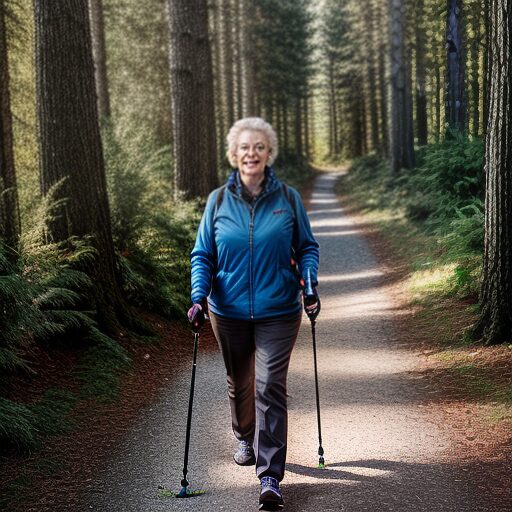
Grip and Strap Usage
When holding your Nordic walking poles, keep your grip relaxed. Your hands should loosely hold the poles with an emphasis on using the straps effectively.
The strap should be snug around your wrist, allowing you to open your hand and let the pole swing without having to grip it tightly. This method helps transfer the force from your arms to the poles, reducing the strain on your joints.
Arm Movement and Coordination
The arm movement in Nordic walking is similar to a natural swinging motion when you walk. Your arms should alternate with your legs, meaning when your left foot steps forward, your right arm does as well, and vice versa.
Remember to keep your elbows straight yet relaxed, not locked, and your arm swinging from the shoulder. This coordinated action engages your core and chest muscles, assisting with an upright posture.
Leg Technique and Stride
Your legs should mimic the natural walking motion, but with a more pronounced heel-to-toe roll. As you step forward, land gently on your heel, and roll through to your toe, pushing off for the next step.
Your stride in Nordic walking can be slightly longer than your regular walk, but it should remain comfortable and not forced. This walking style, complemented by the use of poles, works to align your spine and strengthen your lower body muscles concurrently.
Correcting Alignment Through Nordic Walking
Nordic walking can be an effective method for enhancing your spinal posture and gait patterns. By employing specialized poles and technique, you can improve your postural alignment.
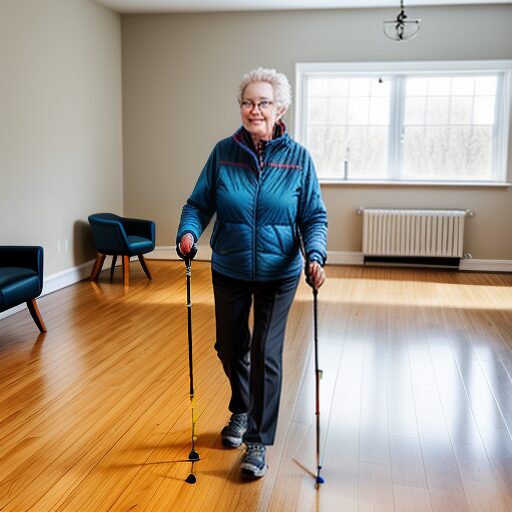
Alignment Assessments
To begin correcting your alignment with Nordic walking, an initial assessment of your current postural alignment and gait is crucial. This assessment can identify areas where imbalances or irregularities exist.
Tools such as video analysis or a professional gait assessment can provide detailed insight into your walking patterns both with and without Nordic walking poles.
Corrective Exercises and Drills
Once imbalances have been identified, you can perform targeted corrective exercises and drills. These exercises often focus on:
- Strengthening the core muscles
- Increasing the flexibility of the spine and lower body
- Enhancing overall coordination
For instance, drills like the pole plant and arm swing ensure proper use of the Nordic walking poles, which is essential for correcting alignment.
Monitoring and Adjusting Technique
Regularly monitoring your Nordic walking technique ensures ongoing improvement in postural alignment. Make adjustments to your form as needed, possibly with the guidance of a certified Nordic walking instructor.
Key technique aspects to monitor include:
- Pole usage
- Stride length and symmetry
- Upper body movement
Advanced Concepts
In pursuit of maximizing the benefits of Nordic walking for posture improvement, further refining your technique with advanced methods can make a significant difference. Let’s examine how pace, terrain, and additional training can enhance postural alignment.
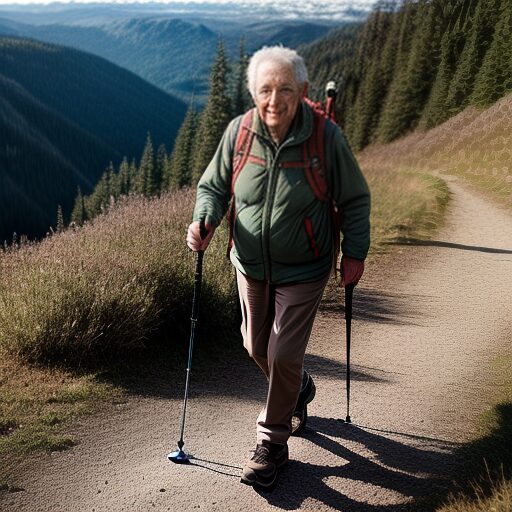
Pace and Intensity Variations
Adjusting your pace and intensity during Nordic walking allows for more dynamic postural engagement.
A faster pace encourages increased heart rate and muscular activation. Integrating intervals of brisk walking with your standard pace can contribute to greater postural control and alignment awareness. (source)
Challenging Terrains
Walking on uneven or inclining surfaces requires additional postural adjustments and muscular control.
Engaging in Nordic walking on varied terrains improves your balance and strengthens postural muscles. Studies have shown that navigating different terrains can enhance stability and postural alignment. (source)
Incorporating Flexibility and Strength Training
To support optimal postural alignment, incorporating flexibility and strength exercises into your routine is vital.
Flexibility training such as stretching enhances muscle elasticity, allowing for better posture during walking.
Adding targeted strength exercises can fortify the muscles that hold your spine in its proper alignment, further augmenting the postural benefits of Nordic walking. (source)
Safety and Precautions
When incorporating Nordic walking into your routine, prioritizing safety ensures a positive impact on your posture without unnecessary risks. Here are key considerations to keep you safe.
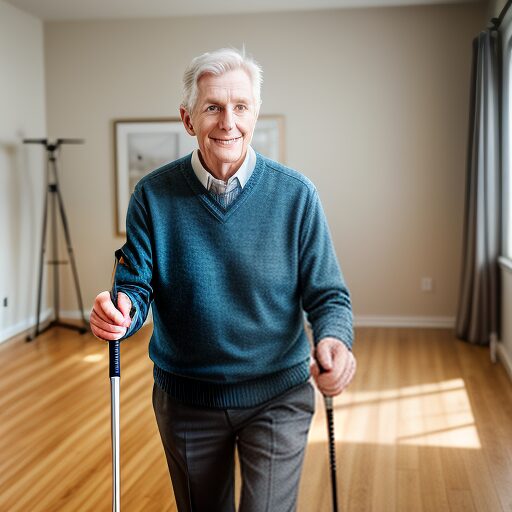
Weather Adaptations
Be prepared for varying weather conditions.
In hot weather, wear breathable clothing and a hat, and ensure you stay hydrated. For cold climates, layer your clothing to maintain body warmth while allowing mobility; also, consider shoes with good traction to prevent slips on icy surfaces.
Injury Prevention
Use proper technique to avoid strain.
Begin with shorter walks to allow your muscles to adapt to the new exercise form.
It’s crucial to choose Nordic walking poles of the correct height to prevent overextension or slouching, which are common causes of injury.
Navigating Traffic and Public Spaces
Stay alert in shared environments.
Always walk on sidewalks or designated paths, be aware of your surroundings, and make eye contact with drivers before crossing roads. If walking in low-light conditions, wear reflective gear to increase visibility.
Community and Motivation
Nordic walking isn’t just an individual activity; it’s enhanced by community involvement, which provides motivation and support. Connecting with a walking group and engaging with social support systems positively contribute to your commitment and enjoyment of the exercise.
Finding Walking Groups
Discovering local Nordic walking groups aligns you with people who share similar fitness goals.
These groups often meet regularly, making it easier to establish a routine. A simple internet search or a check-in at community centers can provide you with options for nearby groups.
Setting Goals and Tracking Progress
Goals are crucial for keeping you on track.
Begin by setting achievable short-term goals, such as a certain number of walking sessions per week. As you progress, these can evolve into long-term objectives, like participating in a Nordic walking event.
It’s helpful to use apps or a journal to track your progress which solidifies your commitment and allows you to see your improvements over time.
Social Aspects and Support Systems
Participation in Nordic walking can help you form social bonds within your walking community.
This camaraderie is not only enjoyable but also encourages regular participation. Support systems built through these social aspects can make it easier to commit to regular exercise, as the group can provide motivation and accountability.
Embracing Better Posture Through Nordic Walking
In our exploration of Nordic walking and posture improvement, we’ve discovered a powerful combination for enhancing alignment and well-being.

Nordic walking, with its engaging full-body workout and focus on spinal alignment, offers a pathway to stronger muscles and better posture. By mastering technique and understanding the principles of proper posture, individuals can correct imbalances and reduce the risk of discomfort and injury.
From the basics to advanced concepts like varying pace and terrain, we’ve seen how Nordic walking can be personalized to suit individual needs. By prioritizing safety, setting goals, and engaging with supportive communities, anyone can embark on a journey toward better posture with confidence.
As we end, let’s carry forward the lessons learned and continue to prioritize spinal health. Whether young or young at heart, the pursuit of better posture remains a timeless endeavor—one that promises lasting benefits for mind, body, and spirit.
Frequently Asked Questions
In this section, you’ll find detailed answers to common queries regarding the impact of Nordic walking on posture and alignment.
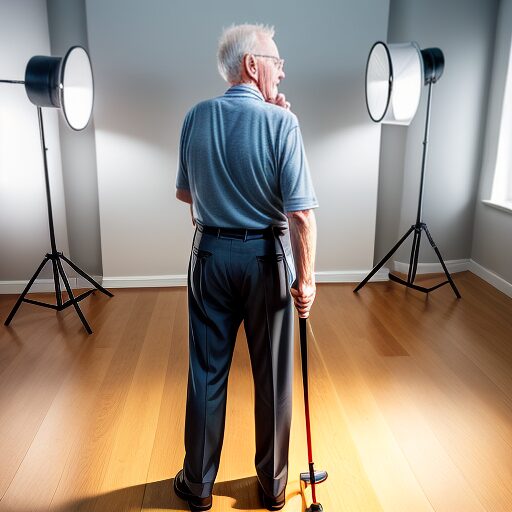
What are the benefits of Nordic walking for correcting poor posture?
Nordic walking engages your upper body, which can lead to improved postural strength. The intentional use of poles encourages a more upright stance and thus can have positive effects on your spinal posture.
How does Nordic walking compare to regular walking in terms of improving spinal alignment?
Compared to regular walking, Nordic walking involves a greater range of motion in the shoulders and upper back, potentially leading to better alignment and posture. It stimulates muscles that are critical for a straighter spine.
Can consistent participation in Nordic walking reverse long-term postural damage?
While individual conditions vary, incorporating Nordic walking into your regular routine may contribute to postural improvements. It may help in mitigating the effects of long-term postural damage by strengthening the back and core muscles. (source)
What are the correct techniques in Nordic walking to ensure posture improvement?
Proper technique in Nordic walking includes maintaining a neutral pelvis and engaging your core muscles. This helps in maintaining an upright posture.
For more detailed techniques, consider resources like Verywell Fit.
How does the use of poles in Nordic walking contribute to postural correction?
The poles in Nordic walking help to redistribute your body’s weight. This allows you to walk upright without slouching.
Research indicates that using poles encourages correct postural alignment.
What are the recommendations for frequency and duration of Nordic walking sessions to achieve better posture?
Experts suggest incorporating Nordic walking a few times a week. Start with sessions of 20-30 minutes.
As you progress, you can increase both the frequency and duration to continue improving your posture.

